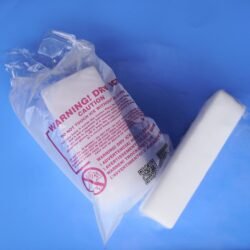What is Dry Ice and Why Use it in a Cooler?
Dry ice is the solid form of carbon dioxide, known for its incredibly low temperature of -109.3°F (-78.5°C). Unlike traditional water ice, dry ice sublimates, which means it turns directly from a solid into gas without becoming a liquid. This unique property makes dry ice in coolers an excellent choice for keeping items frozen or cold during transportation or extended trips. Whether you’re heading on a camping trip, storing perishables, or transporting frozen goods, dry ice offers distinct advantages over traditional ice.
One of the main reasons to use dry ice in a cooler is its ability to maintain freezing temperatures for much longer than water ice. While traditional ice melts and can dilute food and drinks, dry ice keeps everything frozen without adding any moisture. This makes it ideal for situations where you need items to stay completely dry, such as frozen foods, meats, or sensitive items that need to remain cold without water exposure.
Another significant benefit of dry ice in coolers is its ability to last longer under warm conditions. For instance, during outdoor activities like camping or road trips, where temperatures can soar, dry ice blocks or dry ice pellets will maintain their cooling power far longer than regular ice. Additionally, dry ice coolers from Sub Zero Dry Ice are specifically designed to maximize the efficiency of dry ice, helping items remain cold over extended periods.
In this guide, we’ll walk you through how to use dry ice effectively in your cooler, how long it lasts, and what types of coolers work best with dry ice. We’ll also cover safety tips to ensure you’re using dry ice safely and efficiently for all your cooling needs.
How to Use Dry Ice in a Cooler
Packing a Cooler with Dry Ice
Packing a cooler with dry ice requires some careful planning to ensure you’re getting the maximum cooling efficiency. Unlike regular ice, which can be thrown loosely into a cooler, dry ice needs to be packed in a way that ensures it stays effective while also keeping your items safe from direct exposure.
First, it’s important to place a layer of insulation between the dry ice and the food or drinks you’re storing. You can use cardboard, towels, or even layers of newspaper to act as a barrier. This prevents direct contact between your items and the dry ice, which could freeze your goods too quickly or cause damage.
To pack a cooler with dry ice for maximum efficiency, place the dry ice at the top of the cooler. Cold air from the dry ice will sink, helping to keep the contents below cold. Depending on the type of cooler and the items you’re storing, you can also place the dry ice on the sides or bottom, especially if you’re transporting large quantities of frozen goods.
If you’re using a combination of frozen and non-frozen items, consider layering your cooler. Place frozen goods near the dry ice blocks and items that need to stay cold but not frozen further from the dry ice. This ensures that everything stays at the right temperature without over-freezing delicate items.
How Much Dry Ice for a Cooler?
The amount of dry ice you’ll need for your cooler depends on the size of the cooler and the duration of the trip. As a general rule, you’ll need about 5 to 10 pounds of dry ice for every 24-hour period. Larger coolers or longer trips will require more. For example, a medium-sized cooler might require 10 to 20 pounds of dry ice blocks to keep items frozen for an entire day.
It’s important to consider the external temperature and the insulation quality of your cooler when determining how much dry ice is needed. High-quality dry ice coolers from Sub Zero Dry Ice are designed to retain cold air for longer periods, reducing the amount of dry ice needed. However, in warmer conditions or less insulated coolers, you’ll need more dry ice to compensate for the heat.
By carefully calculating how much dry ice is required, you can ensure your cooler is packed efficiently, keeping items cold or frozen for the duration of your trip without running out of cooling power.
Safety Tips for Handling Dry Ice in Various Cooling Systems
When considering dry ice in an evaporative cooler, it’s important to understand the safety protocols associated with handling this extremely cold substance. While it might seem like a convenient way to boost cooling power, dry ice sublimates at -109.3°F (-78.5°C) and releases carbon dioxide gas, which can accumulate in enclosed spaces. If you decide to use dry ice in an evaporative cooler, ensure that the area is well-ventilated to prevent CO2 buildup, which could pose a suffocation risk.
Another common question is, “Can I store dry ice in a freezer?” The answer is no—dry ice should not be stored in a conventional freezer. The extreme cold of dry ice can cause the internal temperature of a freezer to drop significantly, potentially damaging its components and causing it to shut down. Moreover, as the dry ice sublimates, the pressure buildup from carbon dioxide gas within the closed space can become dangerous. Instead, dry ice should be kept in an insulated container with loose-fitting lids to allow gas to escape safely.
By following these guidelines, you can handle dry ice with the caution it requires, ensuring both effectiveness and safety in any cooling application.
How Long Does Dry Ice Last in a Cooler?
Factors That Affect How Long Dry Ice Lasts
The duration that dry ice lasts in a cooler can vary based on several factors, including the cooler’s size, its insulation quality, the amount of dry ice used, and the external temperature. Typically, dry ice in a cooler lasts anywhere from 18 to 24 hours under normal conditions, but several elements can either shorten or extend this period.
One key factor is the size of the cooler and the quality of its insulation. A well-insulated cooler, such as a dry ice cooler from Sub Zero Dry Ice, will help retain cold air longer, reducing the rate at which the dry ice sublimates. Conversely, less insulated coolers allow more external heat to enter, causing the dry ice to sublimate more quickly. This means the type of cooler you use will significantly impact how long your dry ice lasts.
Another important factor is the external temperature. If you’re using dry ice in a cooler in a warm environment, such as during a summer camping trip or outdoor event, the higher ambient temperature will cause the dry ice to sublimate faster. In colder conditions, the dry ice will last much longer, making it ideal for winter camping or events in cooler climates.
The amount of dry ice you use also plays a role. More dry ice will naturally last longer in a cooler, while smaller amounts will sublimate quicker. For larger coolers or longer trips, using more dry ice, such as dry ice blocks, ensures that the cooling effect lasts for the entire duration of your trip.
Average Duration of Dry Ice in a Cooler
On average, dry ice lasts in a cooler for 18 to 24 hours. However, this can vary based on how the cooler is packed and what type of items you’re storing. For instance, if you’re using the cooler to keep frozen goods at sub-zero temperatures, the dry ice may last closer to the 24-hour mark. If the goal is to keep drinks cold but not frozen, the dry ice may sublimate faster due to less dense packing.
If you are packing for a longer trip, consider adding extra dry ice blocks or dry ice pellets to ensure your cooler stays cold for the entire journey. For shorter trips, smaller amounts of dry ice will suffice, but it’s always wise to err on the side of caution and pack more than you think you’ll need, especially if you’re in a warm climate.
By understanding the average duration of dry ice in a cooler and the factors that affect its sublimation rate, you can better plan how much dry ice to bring and how to store it to maximize its efficiency.
Best Coolers for Dry Ice
Choosing the Right Cooler for Dry Ice
Not all coolers are created equal when it comes to using dry ice. The type of cooler you choose can greatly impact how long your dry ice lasts and how well it keeps your items cold. When selecting a cooler for dry ice, there are several key features to look for that will ensure maximum efficiency.
First, insulation is critical. A well-insulated cooler will help retain the cold produced by the dry ice, ensuring that it lasts longer. Coolers with thick walls and high-quality foam insulation are ideal for this purpose. Premium dry ice coolers from Sub Zero Dry Ice are specifically designed to work with dry ice and have superior insulation that can keep the temperature low for extended periods.
Second, the cooler should be airtight or as close to airtight as possible. This helps trap the cold air inside and minimizes the escape of CO2 gas from the sublimation of the dry ice. However, it’s important to note that you should never completely seal a cooler containing dry ice. The buildup of CO2 gas needs a way to escape to prevent pressure buildup, which could cause the cooler to burst.
Additionally, consider the size of the cooler based on your needs. A larger cooler can accommodate more dry ice blocks and keep items cold for longer periods, making it ideal for long trips or large events. Smaller coolers can also work well but may require more frequent replenishment of dry ice.
Popular Cooler Brands for Dry Ice
Several cooler brands are known for their ability to retain cold for long periods, making them great choices for use with dry ice. Brands like YETI, Pelican, and Igloo are popular for their high insulation quality and durability, making them perfect for camping trips, outdoor events, or even extended road trips.
However, for the best performance when using dry ice in a cooler, consider investing in a cooler designed specifically for dry ice, such as the dry ice coolers from Sub Zero Dry Ice. These coolers are built to withstand the extreme cold of dry ice and are equipped with all the necessary features to maximize the effectiveness of your dry ice, whether you’re using it for frozen food storage or keeping drinks cold for a party.
Safety Tips for Using Dry Ice in a Cooler
How to Store Dry Ice in a Cooler
Storing dry ice in a cooler can be incredibly effective, but it’s crucial to follow certain safety precautions to avoid accidents. Properly storing dry ice not only ensures safety but also maximizes its cooling power and longevity. Whether you’re using it for frozen foods or keeping drinks cold, it’s essential to understand the right way to store dry ice inside your cooler.
First and foremost, always use dry ice gloves or thick, insulated gloves when handling dry ice. Direct contact with dry ice can cause frostbite-like burns, as its temperature is far below freezing. In addition to gloves, always use tongs or another tool to move dry ice blocks or dry ice pellets into the cooler to minimize skin exposure.
When storing dry ice in a cooler, ensure that there is adequate ventilation. As dry ice sublimates, it releases carbon dioxide gas. While this gas is not harmful in small quantities, it can displace oxygen in confined spaces. Therefore, never seal a cooler tightly when storing dry ice; leave the lid slightly ajar or create a small opening to allow the CO2 to escape. If you’re transporting the cooler in a vehicle, ensure there is sufficient ventilation to prevent the buildup of carbon dioxide inside the car.
It’s also important to store dry ice away from items that could freeze if exposed to extremely low temperatures. Consider creating layers inside the cooler, using insulation materials like towels or cardboard to separate dry ice from items that don’t need to be frozen. This way, you can prevent the contents from freezing solid while still benefiting from the cooling power of dry ice.
Precautions When Handling Dry Ice
Handling dry ice requires a few important precautions to ensure your safety. As mentioned earlier, dry ice gloves are an essential tool when working with dry ice. Avoid touching dry ice with bare hands, as it can cause immediate frostbite. Always use gloves, tongs, or other insulated tools to move or pack the dry ice.
Another important safety measure is to ensure your cooler is placed in a well-ventilated area. The sublimation process of dry ice produces carbon dioxide gas, and while it’s safe in open areas, it can pose a suffocation hazard in confined spaces with poor ventilation. If you’re using dry ice in a cooler during transport, be mindful of leaving the cooler in an enclosed car for extended periods without ventilation.
It’s also a good idea to plan ahead when using dry ice. Consider the amount of dry ice blocks or dry ice pellets you’ll need based on the size of your cooler and the length of your trip. Always pack more dry ice than you think you might need, especially if you’re heading into a warm environment. By following these precautions, you can safely and effectively use dry ice in your cooler without any risks.
Where to Store Dry Ice Safely Before Use
If you purchase dry ice before your trip or event, knowing where to store it until it’s packed into your cooler is crucial for safety and longevity. It’s best to store dry ice in a well-ventilated area and avoid airtight containers. As dry ice sublimates into CO2 gas, it needs space to expand, and an airtight container could potentially burst due to gas pressure buildup.
Storing dry ice in a regular freezer is also not recommended. The extreme cold temperature of dry ice could damage the freezer’s components, and the CO2 gas could affect the freezer’s internal environment. Instead, you should store dry ice blocks or dry ice pellets in a well-insulated container that isn’t sealed tightly and can handle the cold temperatures. If you’re storing dry ice overnight before a trip, keep it in a dry ice cooler from Sub Zero Dry Ice, which is designed specifically for holding dry ice and maximizing its lifespan.
Maximizing the Efficiency of Dry Ice in Coolers
Keeping Items Cold for Longer
To maximize the efficiency of dry ice in coolers, there are a few strategies you can use to keep your items cold for longer. One effective method is to pre-chill your cooler before adding the dry ice. By placing a bag of regular ice or frozen gel packs in the cooler a few hours before packing it with dry ice, you reduce the internal temperature of the cooler and allow the dry ice to last longer.
Another tip is to layer the contents of your cooler strategically. Place frozen items and those that need to remain coldest closest to the dry ice blocks. Items that don’t need to be as cold can be placed further away from the dry ice. Additionally, using insulated dividers or cardboard can help create layers inside the cooler, optimizing the cold air circulation around the contents.
Using a high-quality cooler with thick insulation, such as a dry ice cooler from Sub Zero Dry Ice, is another way to maximize the longevity of your dry ice. These coolers are designed to retain cold temperatures for longer periods, minimizing the sublimation of the dry ice and ensuring that your items stay frozen or cold for extended trips.
How to Pack Items Around Dry Ice
To get the best results when using dry ice in a cooler, it’s essential to pack your items strategically around the dry ice. Start by placing the largest pieces of dry ice blocks at the bottom of the cooler. This creates a cold base that will help chill everything placed above it. If you’re using smaller dry ice pellets, you can spread them more evenly throughout the cooler, ensuring even distribution of cold air.
Next, layer your items in the cooler according to their temperature needs. Frozen goods should be closest to the dry ice to keep them at sub-zero temperatures, while items that only need to stay cold, like drinks or deli meats, should be further from the dry ice. You can also use towels, newspaper, or insulated bags to create layers and prevent items from freezing if necessary.
Finally, make sure the cooler lid is tightly sealed, but with a small opening for ventilation. This allows the carbon dioxide gas from the sublimation of dry ice to escape without compromising the cooling effect. For extended trips, make sure to check your dry ice periodically and add more if needed, especially in warmer climates.
Conclusion
Using dry ice in a cooler is an excellent way to keep items cold or frozen during trips, events, or transportation. With proper handling and packing techniques, dry ice can last much longer than regular ice, providing cooling power without the mess of melted water. Whether you’re camping, tailgating, or shipping temperature-sensitive products, dry ice blocks and dry ice pellets are the ideal solution for maintaining the cold.
By choosing the right cooler, packing strategically, and following safety precautions, you can ensure that your dry ice lasts as long as possible and that your items remain at the correct temperature throughout your journey. For those looking to purchase high-quality dry ice coolers or need a dry ice shipping service for transporting goods, Sub Zero Dry Ice offers a range of products designed to meet your needs.
Whether you need dry ice blocks or dry ice pellets for an upcoming trip, visit the Sub Zero Dry Ice website to order and get your cooler ready for your next adventure. With the right tools and techniques, you’ll be able to keep your items cold and your experience stress-free.




